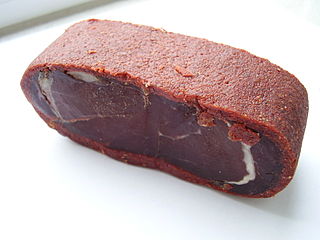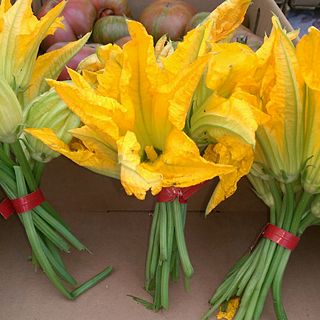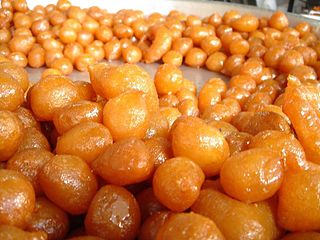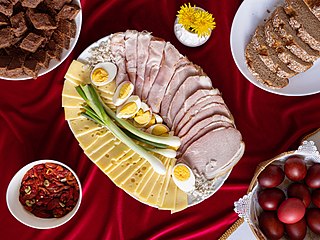| Alternative names | Lalanga |
|---|---|
| Type | Fried flatbread |
| Main ingredients | Flour, yeast, salt |
Lalanga is a deep fried flatbread found in Greek and Turkish cuisines. Historically it was present in both Byzantine and Ottoman cuisines.
Lalanga was present both in the Byzantine and Ottoman cuisines; whilst in the former it was only eaten as a sweet, in Ottoman Turkey it was eaten both as a sweet dish with honey or as a savoury, with cheese. [1] Lalanga continues to exist in the Turkish cuisine, [2] as well as in the Greek Cuisine (mostly in Peloponnese) as Lalagia (In Greek Λαλάγγια). [3]
In the Ottoman printed cookbook, Ali Eşref Dede'nin Yemek Risalesi, there is a recipe as Lalanga. [4]

Turkish cuisine is the cuisine of Turkey and the Turkish diaspora. It is largely the heritage of Ottoman cuisine, which can be described as a fusion and refinement of Mediterranean, Balkan, Middle Eastern, Central Asian and Eastern European cuisines. Turkish cuisine has in turn influenced those and other neighbouring cuisines, including those of Southeast Europe (Balkans), Central Europe, and Western Europe. The Ottomans fused various culinary traditions of their realm taking influences from and influencing Mesopotamian cuisine, Greek cuisine, Levantine cuisine, Egyptian cuisine, Balkan cuisine, along with traditional Turkic elements from Central Asia, creating a vast array of specialities. Turkish cuisine also includes dishes invented in the Ottoman palace kitchen.

Pastirma or basturma, also called pastarma, pastourma, basdirma, or basterma, is a highly seasoned, air-dried cured beef that is found in the cuisines of Turkey, Armenia, the Levant, Azerbaijan, Bulgaria, Egypt, and Greece, Iraq and North Macedonia.

Mediterranean cuisine is the food and methods of preparation used by the people of the Mediterranean Basin. The idea of a Mediterranean cuisine originates with the cookery writer Elizabeth David's book, A Book of Mediterranean Food (1950) and was amplified by other writers working in English.

Tripe soup, tripe stew or tripe chorba is a soup or stew made with tripe. It is widely considered to be a hangover remedy.

Squash blossoms are the edible flowers of Cucurbita species, particularly Cucurbita pepo, the species that produces zucchini (courgette), marrow, spaghetti squash, and many other types of squash.

Börek or burek are a family of pastries or pies found in the Balkans, Middle East and Central Asia. The pastry is made of a thin flaky dough such as filo with a variety of fillings, such as meat, cheese, spinach, or potatoes. Boreks are mainly associated with Anatolia, the Middle East, Armenia, and also with the former Ottoman Empire, including the Balkans and the South Caucasus, Eastern European and Central European countries, Northern Africa and Central Asia. A borek may be prepared in a large pan and cut into portions after baking, or as individual pastries. They are usually baked but some varieties can be fried. Borek is sometimes sprinkled with sesame or nigella seeds, and it can be served hot or cold.

Tulumba or Bamiyeh is a deep-fried dessert found in Turkey and the regional cuisines of the former Ottoman Empire. It is a fried batter soaked in syrup, similar to jalebis and churros. It is made from unleavened choux pastry dough piped with a pastry bag using an open star or similar tip. It is first deep-fried to golden colour and then sugar-sweet syrup is poured over it when still hot. It is eaten cold.

Levantine cuisine is the traditional cuisine of the Levant.

Assyrian cuisine is the cuisine of the indigenous ethnic Assyrian people, Eastern Aramaic-speaking Syriac Christians of Iraq, northeastern Syria, northwestern Iran and southeastern Turkey. Assyrian cuisine is primarily identical to Iraqi/Mesopotamian cuisine, as well as being very similar to other Middle Eastern and Caucasian cuisines, as well as Greek cuisine, Levantine cuisine, Turkish cuisine, Iranian cuisine, Israeli cuisine, and Armenian cuisine, with most dishes being similar to the cuisines of the area in which those Assyrians live/originate from. It is rich in grains such as barley, meat, tomato, herbs, spices, cheese, and potato as well as herbs, fermented dairy products, and pickles.

Byzantine cuisine was the continuation of local ancient Greek cuisine, ancient Roman cuisine and Mediterranean cuisine. Byzantine trading with foreigners brought in grains, sugar, livestock, fruits, vegetables and spices that would otherwise be limited to specific geographical climates.

Ottoman cuisine is the cuisine of the Ottoman Empire and its continuation in the cuisines of Turkey, the Balkans, Caucasus, Middle East and Northern Africa.

Lokma is a dessert made of leavened and deep fried dough balls, soaked in syrup or honey, sometimes coated with cinnamon or other ingredients. The dish was described as early as the 13th century by al-Baghdadi as luqmat al-qādi, "judge's morsels".

Sephardic Jewish cuisine is an assortment of cooking traditions that developed among the Sephardi Jews.

Baklava is a layered pastry dessert made of filo pastry, filled with chopped nuts, and sweetened with syrup or honey. It was one of the most popular sweet pastries of Ottoman cuisine.

Qurabiya is a shortbread-type biscuit, usually made with ground almonds. Versions are found in most Arab and Ottoman cuisines, with various different forms and recipes. They are similar to polvorones from Andalusia.

Balkan cuisine is a type of regional cuisine that combines characteristics of European cuisine with some of those from Western Asia. It is found in the Balkan Peninsula of Southeast Europe, a region without clear boundaries but which is generally considered to at least include the modern countries of Albania, Bulgaria, Romania and Greece and the former Yugoslavia, with the possible exception of Slovenia and northern inland regions of Croatia.
Melceü't-Tabbâhîn(ملجأ الطباخين), the first Turkish cookbook was written in 1844 by Mehmed Kâmil, a scholar of forensic sciences.
Ali Eşref Dede'nin Yemek Risalesi, the second Turkish cookbook was written in 1856 - 57 by Ali Eşref Dede. This book is one of the works written about the dishes of Ottoman period.
Etli makarna is a traditional pasta dish made in Turkey. They are made from meat and paste. It is prepared in Ottoman cuisine.

Balık çorbası(Turkish: Balık çorbası) is the Turkish word for a fish soup or çorba, traditional to Ottoman cuisine. It is included in an 1859 cookbook, the first printed Ottoman cookbook.
{{cite journal}}: Cite journal requires |journal= (help)